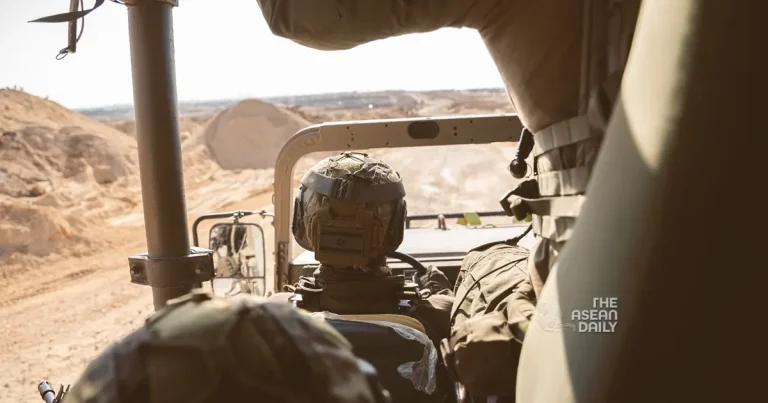5-12-2023 (GAZA) Israel deployed dozens of tanks into southern Gaza on Monday (November 4). This move comes despite increasing global concern over the rising number of civilian casualties.
Following the earlier deployment of ground forces in the north of the Gaza Strip, the Israeli army has now resorted to air-dropping leaflets in southern regions, urging Palestinians to evacuate to safer areas. The Israeli government has expressed its determination to crush Hamas in retaliation for the unprecedented attacks by the militant group on October 7, resulting in approximately 1,200 casualties, predominantly civilians, and the abduction of around 240 hostages, according to Israeli authorities.
The Gaza Health Ministry, administered by Hamas, reports nearly 15,900 fatalities in the territory, with approximately 70% being women and children, as a result of Israel’s relentless air, artillery, and naval bombardments coupled with the ongoing ground campaign. The mounting toll has sparked widespread global concern and triggered mass demonstrations condemning the violence.
Evacuation Orders and Ongoing Military Operations
Israel’s military, on Monday morning, marked approximately a quarter of the city of Khan Younis in yellow on a map, designating it as an area that must be evacuated immediately. The instructions directed people to head south and west towards the Mediterranean Sea and the Egyptian border. Tanks, armored personnel carriers, and bulldozers were observed near the southern city of Khan Younis, which is densely populated with internally displaced Palestinians.
Reports from witnesses indicate that ambulances and private vehicles delivered injured survivors to Nasser Hospital in Khan Younis. Many displaced individuals, already sheltering in makeshift accommodations, sought safety by moving further south, carrying their few belongings on donkey carts, vehicles, and even camels. Unfortunately, airstrikes continued to target them even at the southern border.
Thomas White, Gaza director for the UN’s agency for Palestinian refugees (UNRWA), described the dire situation, stating that people were pleading for advice on where to find safety, but there was nothing they could be told.
Military Actions and Impact on Civilians
According to residents, Israeli vehicles were reportedly 2km inside Gaza in the village of al-Qarara, and tanks were observed moving along the main north-south highway, the Salah al-Din road. The military acknowledged taking “aggressive” action against “Hamas and other terrorist organizations” in Khan Younis, declaring the Salah al-Din road as a battlefield.
Walaa Abu Libda, taking shelter at Al-Aqsa Hospital in Deir al-Balah, expressed the anguish of having her four-year-old daughter trapped under rubble. The conflict has displaced an estimated 1.8 million people in Gaza, constituting roughly three-quarters of the population.
As the Israeli bombing campaign has forced as much as 80% of Gaza’s 2.3 million people to flee their homes, the region has been reduced to a desolate wasteland. Medical officials in Gaza report over 15,500 deaths, with thousands more missing and feared buried in the rubble.
International Response and Humanitarian Concerns
The international community has expressed alarm over the situation, with the United States urging Israel to allow more fuel into Gaza. The U.S. has intensified calls for the protection of Gaza’s civilians, acknowledging a more targeted approach in evacuation requests.
Israel, in response, clarified that it is not seeking to force Palestinian civilians to permanently leave their homes. Military spokesperson Jonathan Conricus highlighted that civilians were asked to evacuate the battlefield, and a designated humanitarian zone named Al-Mawasi was provided within Gaza.
Any suggestion of Palestinian dispersal raises historical sensitivities, particularly in light of the forced displacement during the events surrounding Israel’s creation 75 years ago.
Escalation and Ongoing Ground Operation
The Israel Defence Forces (IDF) announced an extension of its ground operation against Hamas throughout the entire Gaza Strip. Rear Admiral Daniel Hagari, Israel’s top military spokesperson, confirmed that the forces were actively engaging with terrorists, resulting in casualties.
The IDF released footage depicting troops patrolling in tanks and on foot, engaging in fields and damaged urban areas. The military has struck over 400 targets, including extensive aerial attacks in the Khan Younis area, over the weekend.
Despite the collapse of a week-long truce brokered by Qatar, fighting resumed on Friday, leading to the deaths of three more Israeli soldiers in the northern Gaza Strip. The total troop deaths in the region now stand at 75.
As clashes persist, rocket salvos continue to be fired from Gaza towards Israeli territory. The situation has prompted accusations of “genocide” from both Israeli and Palestinian representatives at the United Nations, with both sides demanding an international response.
The occupied West Bank has also witnessed increased violence, with more than 250 Palestinians killed since the beginning of the conflict. Meanwhile, Israeli Prime Minister Benjamin Netanyahu’s corruption trial, suspended during the war’s onset, resumed on Monday. Netanyahu faces charges of bribery, fraud, and breach of trust, which he vehemently denies.




